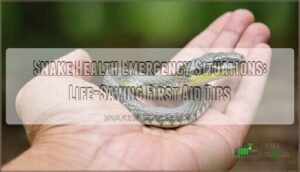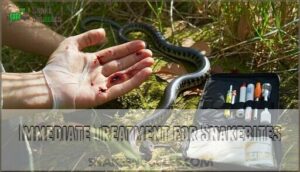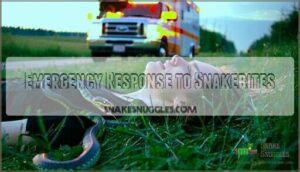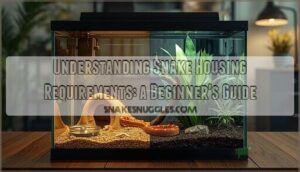This site is supported by our readers. We may earn a commission, at no cost to you, if you purchase through links.

Don’t play hero – venomous bites can turn serious fast. Look for swelling, color changes, or intense pain around the bite area.
Keep the victim calm and still while you wait for help. Remove jewelry near the bite before swelling kicks in.
Never try old-school remedies like tourniquets or ice – they’ll make things worse. Most emergency rooms stock antivenom, but time matters.
The sooner you get professional care, the better your chances of avoiding serious complications that could stick around long-term.
Table Of Contents
- Key Takeaways
- Identifying Venomous Snakes
- Symptoms of Venomous Snakebites
- Immediate Treatment for Snakebites
- Emergency Response to Snakebites
- Diagnosing Venomous Snakebites
- Treatment Options for Venomous Snakebites
- Preventing Venomous Snakebites
- Snakebite Complications and Long-Term Effects
- Special Considerations for Snakebites
- When to Seek Medical Attention for a Snakebite
- Frequently Asked Questions (FAQs)
- What are the signs of illness in snakes?
- Do snakes need care?
- Do snakes have respiratory problems?
- Why is monitoring snake health important?
- Why do snakes need regular health checks?
- How do you protect a snake from respiratory illness?
- How can I tell if my snake is sick?
- What are some specific symptoms of common illnesses in snakes?
- Why is shedding a concern for snake health?
- What are some signs of respiratory problems in snakes?
- Conclusion
Key Takeaways
- Call 911 immediately for any venomous snake bite – Don’t try to identify if it’s venomous first, as symptoms can develop rapidly and antivenom works best when administered quickly
- Keep the victim calm and still while waiting for help – Remove jewelry near the bite before swelling starts and position the affected area below heart level to slow venom circulation
- Never use old remedies like tourniquets, ice, or cutting the wound – These methods make injuries worse and can cause additional tissue damage or complications
- Watch for warning signs that require emergency care – Rapid swelling beyond the bite area, breathing difficulty, dizziness, or uncontrollable bleeding mean you’re dealing with a serious envenomation
Identifying Venomous Snakes
You’ll need to quickly identify whether a snake is venomous to make the right emergency decisions.
Knowing the key differences between harmless and dangerous species can literally save your life or someone else’s.
Types of Venomous Snakes in The US
Anyone hiking in the US should know there are four major venomous snakes to watch for.
You’ll run into:
- Rattlesnake Varieties all over, especially out West.
- Copperhead Subspecies and Cottonmouth Habitats mainly in the East and South.
- Coral Snake Mimicry in the South, but bites are rare.
Arizona is known for its high venomous snake population.
Regional Variations matter—emergency situations can pop up fast!
Characteristics of Venomous Snakes
If you spot a snake with a triangle-shaped head, vibrant bands, or a rattle, you’re looking at classic Head Shapes and Defensive Behaviors of venomous snakes.
These critters don’t mess around—rattling, hissing, and striking are their warning signs.
Quick Snake Identification helps you dodge snakebite symptoms and snakebite complications.
Remember: Venom Delivery is their game, and fast snake bite first aid or antivenom is yours.
Common Venomous Snakes in Different Regions
Now that you know what venomous snakes look like, let’s get specific about where they hang out. Regional Snake Habitats matter.
Here’s the breakdown:
- Southeast: Cottonmouths and copperheads love the humid woods.
- West: Rattlesnakes rule the deserts and rocky trails.
- South: Coral snakes show off their bright bands.
Africa, however, is home to the deadly Black Mamba. Snakebite risk factors shift with Venomous Snake Distribution—grab those Snake Identification Guides!
Symptoms of Venomous Snakebites
When a venomous snake bites, your body usually lets you know fast with pain, swelling, or even some scary stuff like trouble breathing.
Your body sounds the alarm fast—pain, swelling, breathing trouble mean business.
Don’t brush it off—these symptoms can get serious in a hurry, so knowing what to look for could save a life (and maybe your favorite pair of hiking boots).
Common Symptoms of Venomous Snakebites
Snake bites pack a punch—sometimes literally. If you’re unlucky enough to get bitten, don’t brush it off. Venomous snakebites can go from “ouch” to “uh-oh” fast.
Watch for these warning signs:
- Fang marks
- Swelling
- Severe pain
- Discoloration (redness, bruising, blisters)
- Enlarged lymph nodes
- Bloody wound discharge
- Excessive bleeding
- Trouble clotting
- Difficulty breathing
- Nausea and vomiting
- Dizziness
- Blurred vision
- Weakness
- Sweating buckets
- Fever
- Loss of muscle coordination
- Numbness or tingling
If you spot any of these, don’t play hero. Call for snake bite medical attention right away. Quick snake bite treatment can prevent major snake bite complications and keep you safe for your next hike.
Remember that antivenom access is essential for treating venomous bites.
Localized Vs. Systemic Poisoning
Understanding tissue damage helps you respond faster during snake emergency care.
Localized poisoning affects only the bite area, causing swelling, pain, and discoloration – like a bad bruise that won’t quit.
Systemic poisoning spreads throughout your body, creating organ impact and neurotoxic effects.
This venom spread can cause breathing problems, dizziness, and paralysis.
Treatment timing matters because systemic snake toxic exposure becomes life-threatening quickly, requiring immediate snake trauma care.
Symptoms of Pit Viper and Coral Snake Bites
When pit viper symptoms strike, you’ll feel immediate, intense pain and rapid swelling at the bite site.
These venomous snakes pack venom that destroys tissue and disrupts blood clotting. Coral snake symptoms develop differently – minimal pain initially, but neurological effects appear hours later.
Both require emergency response since untreated envenoming can be fatal.
Pit viper symptoms include:
- Severe pain and swelling within minutes
- Metallic taste in mouth (over 30% of cases)
- Bruising and discoloration spreading from bite
- Bleeding from gums or nose
Coral snake symptoms include:
- Delayed onset (1-13 hours after bite)
- Drooping eyelids and slurred speech
- Progressive muscle weakness
- Difficulty breathing or swallowing
Immediate Treatment for Snakebites
When someone gets bitten by a snake, your quick actions can literally mean the difference between life and death.
Whether you’re dealing with a harmless garden snake or a deadly rattlesnake, knowing the right first aid steps will keep you calm and help you respond effectively.
First Aid for Snakebites
When facing a snake bite, stay calm—panic won’t help.
Remove jewelry near the bite immediately before swelling starts. Gently clean the wound with soap and water.
Keep the bitten area below heart level using immobilization techniques to slow venom spread. Never apply tourniquets or try sucking venom—these harm more than help.
A snake bite kit can provide essential tools for initial care. Focus on getting professional antivenom treatment fast.
What to Do While Waiting for Help
Patience becomes your best friend while emergency crews race to your location.
While waiting for help, follow these critical Immobilization Techniques:
- Keep the victim calm and still to slow venom circulation through their system
- Position the affected limb below heart level using gravity as your ally
- Monitor symptoms every few minutes and note any changes in a snake health emergency
- Avoid home remedies like ice, tourniquets, or cutting – these worsen snake injury treatment outcomes
Importance of Seeking Medical Attention
After providing first aid and while waiting for help, seeking immediate medical attention becomes your top priority. Even if you’re unsure whether the snake was venomous, don’t gamble with your health—bite severity can escalate without warning.
Symptom progression happens fast, and delayed effects can surprise you hours later. Professional antivenom access and monitoring equipment aren’t available at home. Your prognosis factors improve dramatically with early intervention. Think of it like a ticking clock—every minute counts when dealing with snake health emergency situations.
A reptile vet or emergency physician can spot snake illness signs and snake health problems you might miss. These emergency situations require professional expertise, not home remedies.
- Bite severity can worsen rapidly without treatment
- Antivenom access requires hospital-grade resources
- Symptom progression monitoring needs medical equipment
- Delayed effects may appear hours after the initial bite
Emergency Response to Snakebites
When someone gets bitten by a venomous snake, every second counts and knowing when to call for help can mean the difference between life and death.
You’ll need to act fast and understand what happens once emergency responders arrive to give yourself or a loved one the best chance of recovery, and this requires acting quickly to ensure the right treatment is administered in a timely manner, which can be the difference between life and death.
When to Call 911 for a Snakebite
Call 911 immediately if you experience severe symptoms like breathing difficulty, rapid swelling, numbness, or discoloration after any snake bite.
These systemic effects and altered consciousness signal dangerous venomous snakebites requiring emergency snakebite medical attention seeking.
Don’t wait—snakebite emergency response saves lives when snakebite first aid isn’t enough.
What to Expect in The Emergency Room
Once you’re wheeled into the emergency room, you’ll quickly discover that snakebite cases get serious attention. The medical team moves fast because time matters more than your insurance card right now.
Here’s what happens next:
- Triage Process – Nurses assess your symptoms and snake identification details immediately
- Antivenom Availability – Staff checks inventory and orders specific antivenoms if needed
- Symptom Management – Pain relief and swelling control start while doctors evaluate severity
- ER Procedures – Blood draws, IV lines, and baseline essentials get established quickly
- Monitoring Complications – Continuous observation for breathing issues, bleeding, or allergic reactions begins
The atmosphere feels controlled but urgent.
Don’t worry if multiple people ask the same questions about snake health emergencies – repetition helps catch important details. Your reptile vet knowledge won’t help here, but describing the snake’s appearance will.
Unlike treating snake respiratory infection or snake skin disease at home, this requires professional snake health management.
Emergency Department Treatment for Snakebites
Upon arrival, emergency department staff will quickly establish IV access and administer antivenom based on symptom severity.
They’ll provide oxygen support, monitor essential signs continuously, and manage pain with IV opioids.
Antibiotics aren’t routinely given unless infection develops.
The team watches for complications like breathing problems or bleeding disorders—you’re getting expert care.
Diagnosing Venomous Snakebites
When you’re facing a potential venomous snakebite, doctors need to play detective to figure out exactly what they’re dealing with.
They’ll examine the bite marks, ask about the snake’s appearance, and run specific tests to determine if venom was actually injected and how much damage it’s causing.
Identifying The Snake and Assessing Venom Injection
When faced with a potential venomous snake bite, quick snake identification and venom assessment become your lifeline.
Recognizing bite characteristics and injection signs helps medical professionals determine the right treatment fast.
Here’s what to look for during species differentiation:
- Fang marks – Two puncture wounds indicate venomous snakebites versus multiple scratches from non-venomous bites
- Snake appearance – Triangle-shaped head, heat-sensing pits, or distinctive color patterns aid snake bite species identification
- Bite location swelling – Rapid tissue swelling around injection signs suggests venom presence
- Pain intensity – Severe, burning pain typically accompanies venomous encounters compared to minor discomfort
- Snake behavior – Rattling, aggressive striking, or defensive posturing during the encounter provides diagnostic clues
Remember, even experienced folks struggle with snakebite species identification under stress, so don’t play detective too long.
Physical Exam and Medical History
How thorough is your initial assessment when someone’s been bitten? Your physical exam and medical history become the foundation for lifesaving treatment decisions.
- Initial Assessment – Check essential signs and hydration status immediately
- Wound Examination – Document bite marks, swelling, and tissue damage carefully
- Medical History – Note allergies, medications, and previous snake encounters
- Signs of Illness – Monitor for systemic symptoms requiring urgent veterinarian consultation.
Identifying the snake, such as noting its triangular head shape, can aid in treatment.
Laboratory Tests for Snakebite Diagnosis
After the chaos of a snakebite, doctors run several laboratory tests to reveal the mystery of what’s happening inside your body.
CBC Analysis checks your blood cell counts while Coagulation Studies reveal if your blood’s clotting properly.
Renal Function tests confirm your kidneys aren’t shutting down, and Muscle Enzymes show tissue damage.
Venom Detection identifies the snake species for targeted treatment.
These diagnostic procedures guide your medical assessment, turning guesswork into precise medical diagnosis for ideal snake health emergency care.
Treatment Options for Venomous Snakebites
Once you reach the hospital, doctors have three main weapons to fight venomous snakebites: antivenom, pain relief, and infection prevention.
Think of it like a medical SWAT team rushing in to neutralize the venom while keeping you comfortable and safe from secondary complications, utilizing antivenom as a key component.
Antivenin and Its Administration
After doctors identify venomous snakebites, they’ll administer antivenom fast.
CroFab treats North American pit viper bites using 4-6 vials initially.
Administration timing matters—you’ll get better outcomes within six hours.
Dosage calculation depends on bite severity and your symptoms.
Adverse reactions like rashes happen in about 16% of cases.
Storage protocols guarantee antivenom stays effective when emergency care arrives.
Pain Management and Wound Care
Once you’ve received antivenin, proper pain management and wound care become your next priorities.
You’ll need thorough pain assessment and systematic wound cleaning to prevent complications.
- Pain Management: Over-the-counter medications help initially, but your reptile vet may prescribe stronger options for severe discomfort
- Infection Prevention: Clean wounds thoroughly with saline solution and apply sterile dressings to promote tissue repair
- Scar Management: Monitor healing progress and follow wound care protocols to minimize long-term snake health problems
Antibiotics and Other Medications
Recovery requires a multi-pronged approach beyond antivenin.
Your doctor will likely prescribe antibiotics for infection prevention, especially important with snake mouth rot concerns.
Pain relief medications help manage discomfort while your body heals. Watch for medication interactions if you take other prescriptions.
Follow dosage considerations carefully – your reptile vet knows best for preventing antibiotic resistance complications.
Preventing Venomous Snakebites
The best defense against venomous snakebites is staying alert and avoiding dangerous encounters altogether.
You can dramatically reduce your risk by learning where snakes hang out and taking simple precautions when you’re in their territory, which can be considered a complete method to avoid dangerous encounters.
Avoiding Snake Habitats and Encounters
Anyone can master snake safety with smart habits.
Staying aware prevents dangerous snake encounters and keeps your family protected.
- Trail Safety: Stick to marked paths and avoid tall grass or rocky areas
- Yard Maintenance: Keep grass short and remove brush piles where snakes hide
- Deterring Snakes: Secure trash cans and eliminate food sources that attract prey
- Pet Protection: Keep dogs leashed and cats indoors in snake-prone areas
- Snake Education: Teach family members to identify local venomous species and retreat slowly
Wearing Protective Clothing and Gear
Beyond avoiding snake territories, you’ll need proper protective gear for outdoor adventures. Think of it as your personal armor against fanged encounters.
Protective Gear Types matter most. Heavy-duty boots should rise above your ankles, while thick gloves protect hands during yard work. Material Matters too—leather beats canvas every time.
Many retailers offer specialized snake protection for outdoor enthusiasts.
Layering Strategies work best with long pants over gaiters. Visibility Importance means bright colors help others spot you quickly during emergencies. Proper Maintenance keeps gear effective through regular cleaning and inspection.
| Gear Type | Protection Level |
|---|---|
| Leather Boots | Maximum |
| Canvas Gloves | Moderate |
| Thick Pants | High |
| Snake Gaiters | Maximum |
| Long Sleeves | Moderate |
Smart snake bite prevention starts with dressing right!
Safe Handling of Snakes and Snake Removal
When encountering a snake, your first instinct might be to handle it yourself—don’t. Professional removal is the safest route for snake relocation and handling risks prevention.
Safe handling requires expertise:
- Call certified professionals who use proper snake handling techniques with hooks and tongs
- Never attempt DIY capture—most snake bites happen during amateur removal attempts
- Focus on entry prevention by sealing gaps and removing attractants from your property
Professional removal costs average $340 but prevents snake bite emergencies. For ideal safety, consider investing in professional-grade snake tongs.
Snakebite Complications and Long-Term Effects
Even if you survive a venomous snakebite, your journey isn’t over.
Complications can pop up weeks or even months later, from permanent nerve damage to kidney problems.
These long-term effects can seriously impact your quality of life if you don’t know what to watch for.
Common Complications of Venomous Snakebites
What happens when venomous snakebites go wrong? Your body faces serious complications that can turn deadly fast.
Tissue necrosis eats away healthy skin and muscle. Coagulopathy messes with blood clotting, causing dangerous bleeding. Respiratory failure makes breathing impossible. Compartment syndrome creates crushing pressure in your limbs. Renal failure shuts down kidneys completely.
These snakebite complications need immediate antivenom treatment. Globally, there are about 600 venomous species that pose a threat to humans.
| Complication | Description |
|---|---|
| Tissue Necrosis | Dead tissue from venom damage |
| Coagulopathy | Blood won’t clot properly |
| Respiratory Failure | Can’t breathe without help |
| Compartment Syndrome | Dangerous swelling pressure |
| Renal Failure | Kidneys stop working |
Long-Term Effects of Snakebites
Venomous snakebites don’t always end when you leave the hospital. Your recovery journey might include some unexpected passengers that stick around longer than you’d like.
Chronic pain becomes a real possibility, especially if nerve damage occurred during the bite. Some folks deal with lingering numbness or tingling that can last months or even years. Psychological trauma is another common companion – many people develop a genuine fear of snakes or outdoor activities after their experience.
Here’s what you might face down the road:
- Mobility issues from muscle or joint damage that affects how you walk or use your limbs
- Persistent swelling and reduced range of motion in the affected area
- Amputation risks in severe cases where tissue death was extensive
The good news? Most people recover well with proper snakebite medical care and snakebite longterm care. Don’t let these possibilities scare you – just stay informed about snakebite complications management so you know what to watch for during your healing process.
Managing Chronic Conditions After a Snakebite
Post-bite recovery requires dedicated chronic pain management and mobility issues rehabilitation. Some survivors face lasting psychological impact from their snake health emergency.
| Challenge | Strategy | Timeline |
|---|---|---|
| Chronic Pain | Physical therapy, medication | 3-12 months |
| Mobility Issues | Range-of-motion exercises | 6 months+ |
| Psychological Impact | Counseling, support groups | Ongoing |
Rehabilitation strategies include regular follow-ups with specialists who understand snakebite complications management. Ongoing monitoring helps catch problems early – think of it as your body’s check engine light. Snake health problems don’t end at discharge, so stick with your snakebite longterm care plan.
Special Considerations for Snakebites
Some snakebites require extra care depending on who gets bitten. Children, pregnant women, and people with health problems face higher risks and need faster treatment than healthy adults.
Snakebites in Children and Pregnant Women
Children and pregnant women face higher risks from snakebites than healthy adults.
Pediatric snakebites pack a bigger punch because kids’ smaller bodies can’t handle the same venom load.
Pregnancy risks include fetal complications and bleeding issues that make treatment tricky.
Antivenom safety becomes extra important here – you’re not just treating one person.
Dosage considerations matter more when body weight varies dramatically.
Here’s what makes these cases different:
- Children under 15 face 20% higher complication rates during outdoor months
- Pregnant women show 2x higher risk of fetal death from venomous snakebites
- Snakebite first aid techniques must account for size and pregnancy status
- Psychological impact hits harder when families are involved
- Snakebite emergency treatment requires pediatric or obstetric specialists
Don’t mess around – get professional help fast for snakebite prevention strategies.
Snakebites in People With Pre-Existing Medical Conditions
Pre-existing medical conditions make venomous snakebites trickier to handle.
Cardiac Conditions can worsen with antivenom reactions, while Immunocompromised Patients face higher infection risks.
Bleeding Disorders complicate treatment since some venoms affect clotting.
Diabetes Impact includes slower healing and medication interactions.
Renal Disease patients need modified antivenom doses.
Always inform emergency responders about your conditions—it’s your medical roadmap for safer emergency department treatment.
Snakebites in Remote or Rural Areas
Being stuck in the wilderness with a snake bite feels like your worst nightmare come true.
When you’re hours from help, every second counts. Here’s your survival playbook:
- Stay calm and immobilize – panic spreads venom faster through your system
- Send someone for help immediately – use satellite communicators or cell boosters for evacuation challenges
- Apply basic remote first-aid – keep the bite below heart level while waiting
Don’t rely on traditional healers or at-home remedies.
Telemedicine options can guide you, but antivenom access requires real medical facilities.
Rural prevention beats treatment every time.
When to Seek Medical Attention for a Snakebite
Knowing when a snakebite demands immediate medical care can literally save your life or someone else’s.
The difference between "I’ll wait and see" and "we need help now" often determines whether you walk away with a good story or face serious complications.
Warning Signs of a Severe Snakebite
When severe snake bites strike, recognizing danger signals can save your life.
Watch for rapid swelling that spreads beyond the bite area, breathing difficulty that leaves you gasping, altered consciousness making you feel dizzy or confused, spreading discoloration creating rainbow bruises, and uncontrollable bleeding.
These red flags mean your body’s fighting serious venom—don’t wait around hoping things improve!
When to Seek Immediate Medical Attention
Three critical signs demand immediate emergency care after any snakebite.
Severe symptoms like rapid swelling beyond the bite area, breathing difficulty, or dizziness signal systemic effects spreading through your body.
Don’t wait—these snake health emergency situations require antivenom access fast.
Call 911 immediately when symptoms worsen or spread rapidly.
Follow-Up Care and Monitoring After a Snakebite
Your recovery journey doesn’t end when you leave the hospital. Think of follow-up care as your safety net against complications that can sneak up weeks later. Your body needs time to bounce back from the venom’s assault.
Key monitoring priorities include:
- Antivenom reactions – delayed allergic responses can occur days later
- Scar management – proper wound care prevents ugly, painful scarring
- Long-term monitoring – some venom effects linger for months
- Psychological support – snake bite trauma affects mental health too
- Rehabilitation exercises – restore full function to affected limbs
Stay alert for warning signs and keep all follow-up appointments scheduled.
Frequently Asked Questions (FAQs)
What are the signs of illness in snakes?
Picture your snake’s usual bright eyes suddenly looking dull and cloudy – that’s your first red flag.
Watch for appetite changes, difficulty shedding, wheezing sounds, skin discoloration, unusual lumps, and behavioral shifts like lethargy or aggression, which can indicate a problem with your snake’s health, particularly signs of lethargy.
Do snakes need care?
Yes, snakes definitely need care! You’ll want to maintain proper temperature, humidity, and feeding schedules. Regular vet checkups help catch health issues early since snakes hide illness well.
Do snakes have respiratory problems?
When your ball python starts wheezing like an old car engine, you’ve spotted trouble.
Yes, snakes definitely get respiratory problems from bacteria, fungi, or poor humidity.
Watch for open-mouth breathing and wheezing sounds.
Why is monitoring snake health important?
You’ll catch problems early since snakes hide illness well. Regular monitoring prevents disease spread, guarantees proper treatment, and keeps your scaly friend healthy longer.
Why do snakes need regular health checks?
Like a car needs regular tune-ups to catch problems before they strand you, snakes hide illness until it’s serious.
You’ll spot early warning signs through routine checks, preventing minor issues from becoming life-threatening emergencies.
How do you protect a snake from respiratory illness?
Keep your snake’s enclosure at proper temperature and humidity levels. Clean regularly, maintain good ventilation, and avoid drafts. Monitor for early respiratory symptoms like wheezing or mouth breathing.
How can I tell if my snake is sick?
Watch for appetite changes, breathing issues, skin problems, behavioral shifts, and unusual discharge.
Your snake can’t tell you when something’s wrong, so you’ve got to become a detective.
Look for lethargy or aggression too.
What are some specific symptoms of common illnesses in snakes?
You’ll notice respiratory issues like wheezing and mouth breathing, skin problems including retained sheds and dark patches.
Appetite changes, weight loss, behavioral shifts like aggression, and swelling or lumps on your snake’s body.
Why is shedding a concern for snake health?
Ironically, shedding seems natural but becomes problematic when it doesn’t happen properly.
You’ll see retained skin pieces, especially around eyes and tail tips, restricting blood flow and potentially causing infections or blindness if left untreated.
What are some signs of respiratory problems in snakes?
You’ll notice wheezing sounds, open-mouth breathing, and unusual respiratory noises.
Your snake might also show mouth breathing instead of normal nose breathing, along with excessive mucus around the nostrils or mouth area.
Conclusion
Remember what you just learned – snake health emergency situations demand lightning-fast decisions.
You’ve got the tools now: recognize danger signs, stay calm, and act quickly.
Don’t second-guess yourself when someone’s life hangs in the balance.
Skip those old wives’ tales about tourniquets and ice.
Instead, call 911 immediately and follow proper first aid.
Your quick thinking could mean the difference between a full recovery and serious complications down the road.
- https://my.clevelandclinic.org/health/diseases/15647-snake-bites
- https://www.ncbi.nlm.nih.gov/books/NBK557565/
- https://www.who.int/news-room/fact-sheets/detail/snakebite-envenoming
- https://www.redcross.org/take-a-class/resources/learn-first-aid/venomous-snake-bites
- https://www.cdc.gov/niosh/outdoor-workers/about/venomous-snakes.html




















